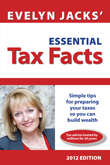Last updated: February 15 2012
Evelyn Jacks: The Taxman plays Cupid
We don't often think of the taxman as cupid, but this month, you may have received a Valentine's Day treat: the timely delivery of your 2011 RRSP Deduction Limit Statement. Canada Revenue Agency dropped this simple, one-page form ó complete with easy-to-read definitions ó into the mail early in February, to remind eligible Canadians of their correct RRSP deduction limits.
This very useful information arrived in the usual fearsome, brown, CRA envelope. If you trembled and hid it at the bottom of your burgeoning pile of unopened mail, go dig it out. By noting the important information on this form and making the correct RRSP contribution, you'll reduce your net income (line 236 of your income tax form). That is the number used to generate a host of tax goodies:
- Refundable tax credits such as the federal GST/HST Credit, Canada Child Tax Benefits and Working Income Tax Benefit. Many provinces have refundables, too, so RRSP-reduced net income can influence cash flow throughout the year.
- Non-refundable tax credits, such as the Spousal Amount, Age Amount, Caregiver Amount, and Tuition, Education and Textbook amounts, to name a few.
- Social benefits such as the Old Age Security and Employment Insurance benefits, which are clawed back at certain net-income ceiling thresholds.
Moreover, a lower net income can also decrease provincial pharmacy deductibles and per diems at nursing homes.
So, take a peek at your RRSP Deduction Limit Statement. It is easy to read and tells you in very plain terms:
- Your RRSP deduction limit for 2010 and how much of that you used on last year's tax return. That leaves you with your unused RRSP deduction limit at the end of 2010.
- Your RRSP deduction limit for 2011, which may include a variety of adjustments related to your employer-sponsored pension plan, if you have one. Those adjustments might increase or decrease your RRSP deduction limit.
This second figure is next to a prominent figure (A). Find it and circle it. For most people, this is the exact amount you can contribute to your RRSP and you should do so by Feb. 29, 2012, if you are to get the deduction that will reduce your 2011 net income. It is very helpful to show the statement to your financial advisor, or the person at your financial institution who will sell you the RRSP.
That's because this form also notes whether you have any unused RRSP contributions available for 2011. This is labelled, albeit not as noticeably, as Amount (B). That's the amount you previously invested in your RRSP, but have not yet deducted on your tax return.
It's important to pay attention to this number because sometimes too much of a good thing ó an excess contribution ó can attract a 1%-a-month penalty. That happens when your unused RRSP contributions (B) are more than your deduction limit (A) plus a $2,000 "buffer zone.î (Note: minors aren't allowed the buffer zone.)
If that's too much information and the dreaded tax tremors are back, visit your tax advisor, who will know what to do about your over-contribution and excess contribution. Just between you and me, tax pros tremble at the thought of having to complete the dreaded 1% penalty form, a T1-OVP, so they're motivated to keep you out of the penalty zone!
It's Your Money. Your Life. Treat yourself to more cash flow throughout the year and more accumulated, tax-deferred capital by looking over your 2011 RRSP Deduction Limit Statement and then making your correct RRSP contribution by Feb. 29.


